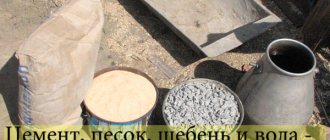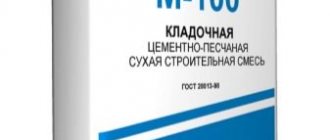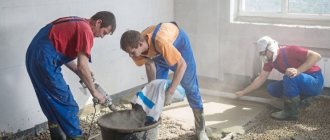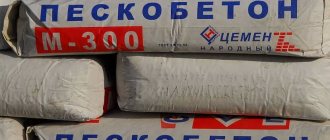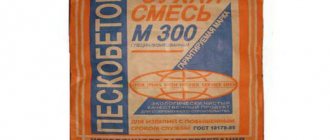CPS M300 is a universal sand-cement mixture that is very often used in various types of repair and construction work. This solution can act as durable concrete for pouring floors, foundations, certain structures, and can be used as plaster, masonry mixture, etc.
A variety of additives can be added to the M300 mixture to change certain characteristics and parameters of the solution, making it suitable for a variety of tasks. The use of dry sand concrete makes it possible to highly accurately predict the properties of the future solution, calculate the consumption of the product per square/cubic meter, and anticipate the completion time of the object.
The dry mixture produced in the factory, unlike the one prepared by hand, does not shrink and guarantees the presence of all the characteristics regulated by GOST. Preparation of the solution in this case requires a minimum of effort - just mix the mixture with water according to the instructions on the package.
In addition, such a solution, thanks to a clear calculation of the components, always turns out to be mobile, plastic, and comfortable to work with.
Composition of sand concrete M300:
- Portland cement grade M500 - up to 25% of the total weight of the mixture
- Fractional sand, crushed stone chips, granite screenings - up to 75% of the total mass
- Mineral additives (anti-frost, plasticizers, hydrophobic and others)
- Fiber fiber - only if addition is required by production
As a rule, a filler of two fractions is added to the M300 sand concrete mixture - medium-grained quartz sand 0.8-2 millimeters in size and large chips/screenings 4-8 millimeters in size. Thanks to these components, it is possible to obtain a durable solution that does not shrink, subject to minimal binder consumption. To create cheaper materials, it is allowed to use washed sand of 1-5 millimeters in size.
Specifications
The cement-sand mixture requires several preparation algorithms, which is influenced by the area of use. So, for plastering they use a solution with lime, for general construction and masonry mixtures they use M150/M200. For concreting, pouring monoliths, leveling foundations, it is best to choose M300. This brand is designated on the packaging as sand concrete.
Main properties and parameters of sand concrete M300:
- Compressive strength by grade - 30 MPa a month after pouring (that is, after the full period of strength development). This parameter is checked in the laboratory. Factors such as dosage, quality of materials, and correct preparation are important here.
- Load – sand concrete can withstand a load of 300 kg/cm2.
- The maximum filler amount is selected in accordance with the purpose of the solution. Gravel of a fraction of 5-8 millimeters is relevant for pouring reinforced concrete products, blocks and slabs. Screening of a fraction of 2-5 millimeters is suitable for screeding and creating various concrete products (paving slabs, curbs, fences). The finest fractions of filler are used when preparing a solution for plaster or other type of decorative finishing.
- The level of water resistance is almost zero: after the concrete has gained strength, less than 1% moisture remains in the monolith. Thanks to the introduction of special additives into the composition, it is possible to achieve even lower indicators that are relevant for the construction of underwater/underground structures.
- Frost resistance - the number of freezing/thawing cycles (which can be roughly compared with years of service in the northern and central regions of Russia) is F35-F50.
- The ability to retain water - this indicator is important when laying, because if the solution loses water quickly, the monolith may become covered with cracks and lose strength. High-quality mixtures assume a value within 95% or more.
- Working temperatures - cement-sand mortar can be laid at a temperature of +5-30 degrees, if special additives are included in the composition, it can work at -5C.
- Setting speed - indicates the time during which concrete must be used and is equal to 2 hours (from mixing to starting the reaction). But the value can change significantly under the influence of temperature, constant mixing, and when adding different additives.
- Adhesion - the composition reliably adheres to the base and a force equal to or greater than 4 kg/cm2 is required for tearing off.
- Good sound/heat insulation characteristics.
- Resistant to sudden temperature changes and corrosion.
The table shows more detailed technical characteristics:
Types of materials
Sand-cement mixture M300 is used in a wide variety of repair and construction areas. The material is divided into types according to its purpose. Thus, sand concrete is most often used to create a wear-resistant, high-strength floor screed with the possibility of not having to perform additional coating.
The solution is often used to restore partially cracked or crumbled structures, create concrete products, and various types of paving slabs. TsPS 300 is ideal for plastering/masonry mortar - in this case, the mixture is prepared from a filler fraction of less than 2 (for plastering) and 4 (for masonry) millimeters.
Sand concrete M300 is used for the production of expanded clay concrete grade M200 by adding crushed stone or expanded clay to the mixture in a 1:1 proportion to the volume of dry material. Precise instructions regarding the ratio of dry mixture and water, optimal working time and setting, as a rule, are indicated on the container with sand concrete.
On average, they take 1.5-2 liters of water per 10 kilograms, work with the solution for 1-2 hours, and it sets in a day or two, gaining full strength within a month. If you overdo it with water, concrete can shrink greatly, cracks often appear, and technical characteristics deteriorate.
The exact proportions and types of mortar are prepared for each case individually, taking into account the specific properties and parameters, as well as the scope of application of concrete.
Manufacturers
Each manufacturer involved in the production of this building material must have a quality certificate guaranteeing compliance of sand concrete with regulatory standards. The construction market offers a wide range of this type of product. Experts single out only 2 domestic ones, which produce sand concrete of the best quality and price. A bag of dry mixture of these brands weighs 25-40 kg, the average price is 3000-3600 rubles. The full range of products is offered by:
- "Leroy Merlin";
- "MKU Standard";
- "Reference";
- "Luix";
- "TSPS Finstroy";
- "Stock M-300 Krepts."
Material consumption per 1 m2, 1 m3
A dry mixture of sand and cement is quite in demand on the market today. The thing is that such concrete is easy to prepare, it is relatively inexpensive, and gives good results in the form of brand strength, frost resistance, and other important indicators.
To obtain a solution, you simply need to add water in the indicated volumes. Also on the market you can find dry mixtures with plasticizers that change certain characteristics. During the production process, chemical impurities are added to the powder, improving qualities such as water resistance, adhesion, resistance to frost, wear, mobility, ductility, strength, etc.
Any sand-cement mixture assumes a specific purpose, based on which components and proportions are selected. The main importance is strength; the type of solution being mixed and the proportions of the components in the composition depend on it. So, for the M100 brand, cement and sand are taken in a ratio of 1:3.
To calculate how much sand concrete is needed per 1 m2, 1 m3, you first need to determine the average consumption of the sand-cement mixture - this figure is 1.7-1.9 kilograms per millimeter of layer. The main thing here is thickness. If the layer thickness is 2 millimeters, the material consumption will be 3.6 kilograms; for a thickness of 5 millimeters you will have to spend 9 kilograms per square centimeter.
If we take practical values, then usually pouring a floor with a layer thickness of 1 centimeter requires 21-22 kilograms of material per cm2. That is, for 20 square meters of floor 1 centimeter thick, 400 kilograms of M300 sand concrete are needed. In accordance with the number of centimeters of layer thickness, this indicator is multiplied by the required value.
Regardless of the task for which the mixture is needed, to obtain a cubic meter of material, you need to use a cubic meter of sand. The proportion looks like this: 1:3, in accordance with it the required volume of cement is found. So, to obtain a cubic meter of M300 sand concrete solution, you need to take 465 kilograms of sand and 490 kilograms of M400 cement or 410 kilograms of M500 cement.
How to determine the “zero” level
The key to successful floor filling is the correct determination of the zero level. To do this, first of all you need to find the highest
floor point, then add 3-5 centimeters to it. This value will determine the “zero” level. After this, using special devices, the same level is established throughout the entire area of the apartment. This stage should be given special attention, since the quality of your actions will determine the quality of floor coverings throughout the room.
Sand concrete Rusean M300 Luiks, 40 kg
Proportions for DSP
To prepare sand concrete, different proportions are used. So, if you plan to build walls, then take a proportion of 1:4 - which means that to obtain a cubic meter you will need 350 kilograms of cement. When preparing mortar for laying sand-lime bricks, the consumption is 0.22 cubic meters.
When building load-bearing walls, high grade cement is used. If lime is added to the composition, then the proportion is 1:3. Water is usually added according to instructions or approximately, controlling the consistency of the solution until the desired density, viscosity, drying time, etc. are obtained.
Features of calculating sand-cement mortar
The proportions of the components are selected so that small fractions of filler fill the space between large ones evenly. In this case, the material consumption and its density are higher than in conventional mixtures. To account for the costs of sand concrete M 300 for performing a certain type of work, the total volume of concrete is first determined.
How to determine the volume of a solution:
- Pouring monolithic walls, reinforced concrete products - calculations are carried out using standard geometric formulas (reinforcement is not taken into account).
- Masonry - technological standards for material consumption.
- Pouring floors and plastering - calculating the total surface area and the expected layer of mortar. As a rule, the average distance from the base to the beacons (markings) is measured in several places over the area.
On the packaging of the mixture, costs are usually indicated based on the consumption of sand concrete per square centimeter, provided that a layer 1 centimeter thick is created. Average values on packaging are usually 18-22 kilograms. To get the flow rate per cubic meter, multiply the resulting value by 100.
How to reduce costs for sand concrete:
- All grades of material are supplied in bags weighing 25-50 kilograms and fully marked. If there is no information on the packaging, as well as an indication of the standard weight, you should not risk buying a low-quality mixture.
- It is more profitable to buy large bags - loading/unloading is cheaper, and the material itself is cheaper in bulk (5-15%).
- On the other hand, you should not buy too much of the mixture, since the shelf life of cement is short and you will simply have to throw away the excess. At any convenient time in Moscow and the regions, you can purchase additional material without stopping production.
- When choosing a supplier, they will find out the cost of delivery - due to the poor location of the warehouse, transportation can increase the price by 25-50%.
- It is undesirable to buy very cheap cement - rarely does a manufacturer agree to supply its product much cheaper than its competitors. Most likely, a low price is an indicator of the same quality.
Calculation for materials
Sand concrete M300 is mixed with cold water at temperatures up to +20 degrees without any impurities in the composition. Water consumption is determined by the proportion: 10 kilograms of dry mixture requires 1.7 liters of water. Mix the solution with an electric drill with a special attachment.
If you plan to prepare large volumes, use a concrete mixer. To improve the quality of mixing, first pour two-thirds of the volume of water required for the composition into the drum, then add it as the concrete mixer works. The solution should be viscous, homogeneous, and plastic. Before starting to work with it, it is advisable to soak the concrete for 10 minutes.
Then you can work with the solution: pour out the concrete and level it with a rule or spatula, then remove air bubbles with a vibrator or bayonet.
For plaster
To prepare the mixture, the relevant proportion is 1:3. You will need about 17 kilograms of cement per square meter with an average thickness of the plaster layer.
For masonry
Here special attention is paid to the sand - it must be clean, without impurities or inclusions. Only in this case will it be possible to knead a homogeneous mass that can reliably hold the masonry material together. The proportions used are different: both 1:3 and 1:6. Consumption per square centimeter is 0.05 m3.
For screed
For floor screeding, M150/M200 grade mortar is usually used. Take cement and sand in a ratio of 1:3 or 1:2 (depending on the brand of cement used). Fiber fiber is often added to the solution in volumes of 800 grams per cubic meter. Consumption is 20-21 kilograms per square centimeter.
Cement-sand mixture is one of the most popular repair and construction materials. But a large range of products makes it difficult to choose the optimal composition. Therefore, calculations must be performed carefully and carefully, following the technology and taking into account the scope of use of concrete.
Price
If you plan to purchase M300 sand concrete, the price per bag (50 kg) will be at least 170 rubles. Based on the total volume of construction, it is easy to estimate the final level of costs.
Sand concrete is a dusty product, so when working, the use of personal respiratory protection and gloves is required
The material is very easy to manipulate: all stages - preparation, mixing, pouring - are available for independent execution , however, it may be necessary to hire a small team of workers.
Experienced builders recognize the advisability of using sand concrete when carrying out interior and exterior work. However, the home master should take into account: in order for the mixture to retain all the declared characteristics, it is necessary to comply with the storage and transportation conditions.
Practical production of sand concrete m300, its composition and proportions per 1m3 are shown in the video:
